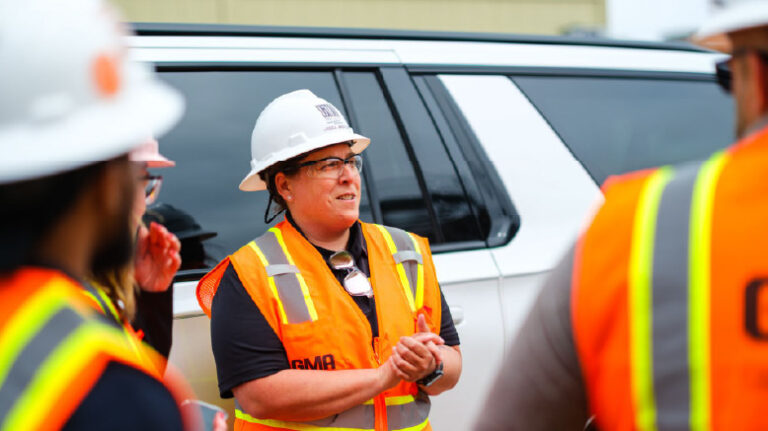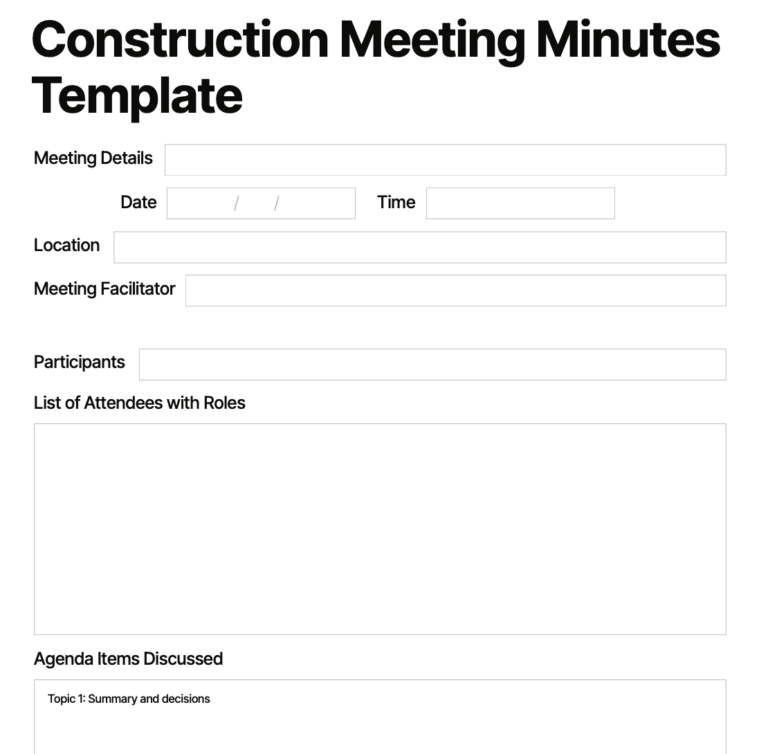Related Articles
— 7 min read
Making the Most of Construction Meetings

Last Updated Aug 19, 2025

Tamara Aspeling
Writer & Construction Estimator
10 articles
Tamara Aspeling is a trained construction estimator and project manager with 25 years of industry experience. She started writing professionally in 2008 and has since written extensively for the construction industry, including publications like Modular Advantage magazine. She is also a traditionally published nonfiction author and the owner of The Construction Writer Inc. Tamara studied at Western Province Technical College in South Africa and completed her national certificate in 1999. She also holds an SEO Certification from Google and a Content Marketing Certification from HubSpot.
Last Updated Aug 19, 2025

If there’s one thing that most construction professionals dislike more than paperwork, it’s meetings. But like paperwork, meetings are a key part of the construction process. While they can take up a lot of time, meetings are an important part of collaboration, communication, problem-solving and building a productive team culture.
This article will look at some of the most important types of construction meetings, plus strategies to make them more efficient and get the most out of them.
Table of contents
Why Meetings Still Matter
With so many ways to communicate today — from quick video calls to emails to a growing adoption of construction management software options — it's fair to ask why construction meetings are still necessary.
While digital tools have changed how construction meetings happen, they haven't eliminated the need for them.
The truth is, construction professionals, whether in the field or the office, are busy. Inboxes are overflowing, and many have multiple projects running simultaneously. Emails can get lost in a game of digital tag or, worse, end up in the junk folder. Phone calls are often forgotten, and memos go unread.
Meetings bring everyone together in the same place at the same time, whether in person or online, and create a record of what was discussed. This helps give everyone clarity on next steps and allows for on-the-spot problem-solving.
When run correctly, meetings can help make sure different stakeholders are aligned, everyone is working from the same information, and progress is monitored. They also help anticipate issues and assign accountability for action items.
When we first started doing kickoff meetings, we didn’t go as in-depth as we do now. These meetings can seem kind of long-winded, but they’re really important to make sure you start your project off on the right foot in a streamlined way. And a big takeaway from us doing these for so long, is that as things change, we have continually found better ways of doing things. I think of the agenda as a living document—it’s a starting point to make sure we have a full detailed conversation. And we update it when we need to.

Nate Belcher
Assistant Project Manager
Hubbell Realty
The Key Types of Construction Meetings
Large construction projects involve many different stakeholders at various levels. This can include a project engineer, architects, designers, owners' representatives, and construction managers at the top. Below them, you'll find estimators, project managers, operations managers, and other professionals who work for a general contractor. Then there’s the field, which includes superintendents, supervisors, subtrades, health and safety representatives, and many others.
It would be difficult to get everyone involved in a large construction project in the same room at the same time. So, instead, there are specific meetings for different things. Attendees are responsible for communicating and informing people within their chain of command.
Some common types of meetings include:
Pre-bid Meetings
Also known as a pre-bid conference, this meeting is held by a project owner or architect to help contractors understand a project before they submit a bid. These information sessions happen shortly after project documents are sent out and a few weeks before bids are due.
Preconstruction Meetings
Held before construction begins, preconstruction meetings usually focus on the project scope, establishing communication channels, defining authority and responsibilities, and clarifying any specifications.
Kickoff Meetings
A project kickoff meeting often includes the owner's team and the prime contractor's project management team, and sometimes includes site superintendents and other field-level administrators. They explore the project's methodology so everyone is on the same page about how the project will start and its overall goals.
Site Meetings
Held on-site, these frequent meetings keep lines of communication open and help solve problems as they arise.
Contractor's Weekly Meetings
Many contractors hold their own meetings without the professional team to focus on construction-specific issues, such as equipment and supply chain needs, staffing, subcontractor performance and an overview of safety issues.
Monthly Project Management Meetings
These meetings focus on productivity, including scheduling, cost issues, change orders, progress billing and project progress.
Construction Safety Meetings
This type of meeting is dedicated to construction safety, and can include elements like safety training, discussing near misses and incidents and issuing personal protective equipment (PPE).
Contingency Planning Meetings
A higher-level meeting, often led by the prime contractor, that focuses on identifying risks and developing strategies to mitigate them. Part of this may involve creating a construction contingency fund.
OAC (Owner, Architect, and Contractor) Meetings
When particularly important decisions need to be made, an OAC meeting may be required. These meetings usually include the general contractor, professional team, subcontractors and owners' representatives.
Company All-hands Meetings
A company-wide meeting to share information, updates and company news.
There may be other types of construction meetings depending on the project. Some are planned far in advance, while others might be called on short notice in response to a specific event. For example, an emergency meeting might be convened if a serious health and safety incident occurs on-site.
OAC meetings create a routine of taking care of business in a way that considers different perspectives and utilizes diverse expertise. This leads to more informed and efficient decision-making, as the people in the room are in charge of the budget, the plans and the schedule, respectively.

Fernando Munoz
Product Designer
Procore
The Purpose of Construction Meetings
Some might say the purpose of meetings is to waste time, but in the construction world, that's rarely the case. Successful projects run on communication and information, and meetings are an effective way to share information with a large group at the same time.
The goals of meetings include:
- Ensuring alignment on goals, timelines, and specifications
- Enabling real-time problem-solving
- Creating easy communication and collaboration channels
- Building relationships by introducing new team members
- Tracking progress and identifying delays early
- Helping the project team make decisions quickly
- Sharing information about specific requirements, like quality and safety standards
- Assigning responsibility and ensuring accountability
Construction projects are massive undertakings with dozens or even hundreds of stakeholders. Meetings remain one of the most effective ways to align everyone and keep the team moving in the right direction.
Making Meetings More Effective
While they can be time-consuming, construction meetings are a powerful tool for keeping projects on track. Many simple strategies can help improve their effectiveness.
Designate a meeting chair.
Every meeting type should have one person who acts as the chair to keep things on track and on topic.
Prepare an agenda.
An agenda should include minutes and action items from previous meetings so everyone knows what will be discussed.
Invite only key stakeholders.
Keep it simple: Only people directly involved in the discussion should be on the invite list.
Use technology.
Share data more easily with video, photos and other visual aids. Some teams may even be able to benefit from an AI note taker during the meeting.
Set clear goals and deadlines.
Assigning specific action items to a team or person with a deadline helps make sure everyone knows what comes next and helps attendees leave the meeting feeling prepared and ready for next steps.
Keep the meeting as short as possible.
Good meetings don't need to be long. The less time spent covering key points and finding solutions, the better.
Using Construction Meeting Minutes
Keeping meeting minutes helps to document decisions and action items, track progress and can be used as official records in case of a dispute. They can improve accountability and provide a centralized record for everyone involved in a project.
Meeting minutes templates are a great tool for making sure that all relevant information is included and organized in a standard format. This not only makes it easier for stakeholders to find the information they need, but also helps improve communication and accountability across a project.
A standardized format makes it easier to track progress, and having a consistent record of decisions and action items can be valuable for future reference or legal backup.
Free Download
Construction Meeting Minutes Template
This free fillable PDF template has all the fields to get started creating a standardized set of meeting minutes for any type of construction project.
- Easy-to-use fillable PDF
- Reuse across multiple projects
- Trusted by construction professionals


Meetings Keep Things Moving
Construction projects demand a level of communication, collaboration and information sharing that is unique to the industry. Everyone from field crews to project owners has valuable input, and keeping that information flowing is an important priority. Meetings are still one of the best ways to make sure that happens.
While it’s a good idea to accept meetings as a necessary part of the construction process, it's also wise to consider if a meeting is truly needed or if an email will suffice. Use technology whenever possible, like a construction project management system with document control tools, to keep everyone updated on the latest information outside of scheduled meetings.
Even with all the tools available, construction meetings are still necessary, and it’s usually better to schedule them early and on a routine basis. The more often you meet, the shorter your agenda is likely to be, which means everyone can get back to building faster.
Was this article helpful?
Thank you for your submission.
0%
0%
You voted that this article was . Was this a mistake? If so, change your vote
Scroll less, learn more about construction.
Subscribe to The Blueprint, Procore’s construction newsletter, to get content from industry experts delivered straight to your inbox.
By clicking this button, you agree to our Privacy Notice and Terms of Service.
Thank you!
You’re signed up to receive The Blueprint newsletter from Procore. You can unsubscribe at any time.
Categories:
Written by

Tamara Aspeling
Writer & Construction Estimator
10 articles
Tamara Aspeling is a trained construction estimator and project manager with 25 years of industry experience. She started writing professionally in 2008 and has since written extensively for the construction industry, including publications like Modular Advantage magazine. She is also a traditionally published nonfiction author and the owner of The Construction Writer Inc. Tamara studied at Western Province Technical College in South Africa and completed her national certificate in 1999. She also holds an SEO Certification from Google and a Content Marketing Certification from HubSpot.
View profileExplore more helpful resources

AI Construction Tools: Optimizing Every Stage of Construction
Builders, like everyone else, are being bombarded with information about incorporating AI into their work. However, determining which areas to automate can be challenging. This article explores the features of...

Construction Technology Data Analytics: The New Standard in Construction
Much of the newest wave of construction technology is impressive: drones performing site surveys, 3D printers manufacturing walls on-site, 360° reality-capture cameras, and more. But all this visible technology collects...

Construction Document Management Software: Revolutionizing Documentation
Managing the numerous and intricate details of modern construction projects can be a daunting task. Construction document management software is a cloud-based digital platform that transforms how all that project...

How Construction Technology is Transforming Safety, Efficiency, and Sustainability
The construction industry is taking part in a remarkable transformation as the sophistication and availability of construction technology have exploded in recent years. The term “construction technology” has become a...
Free Tools
Calculators
Use our calculators to estimate the cost of construction materials for your next project.
Templates
Find a template to help you with your construction project tasks.
Material Price Tracker
Get the latest U.S. retail prices and view historical trends for common building materials.
Glossary
Explore key terms and phrases used in the industry.
